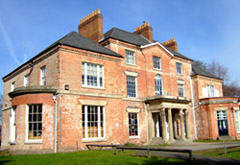Edwin Bullock 1802 - 1870
November 14, 2009
 Edwin Bullock ?1802 -
1870
was an
ironfounder
or
ironmaster,
spring loader hinge
maker,
and noted art
collector,
and a
Trustee
and on the Management Committee of the Birmingham Homeopathic
Hospital,
and a
Trustee
of a Harmsworth School in Birmingham,
Edwin Bullock ?1802 -
1870
was an
ironfounder
or
ironmaster,
spring loader hinge
maker,
and noted art
collector,
and a
Trustee
and on the Management Committee of the Birmingham Homeopathic
Hospital,
and a
Trustee
of a Harmsworth School in Birmingham,
Edwin Bullock was a close friend of Josiah Mason, who was an English pen manufacturer, Philanthropist, Trustee and member of the Management Committee, and major sponsor of the Birmingham Homeopathic Hospital, and the Co-founder of the Mason Science College in Birmingham, which evolved into the University of Birmingham,
Edwin Bullock was a close friend of Joseph Gillott, a steel pen maker and art patron (who was also a business colleague of Josiah Mason),
Edwin Bullock lived at Hawthorn House, Handsworth Wood, Birmingham,
The two great sales of 1870 were the collections of Edwin Bullock and Charles Dickens. “Mr. Bullock,” says the Daily News of May 20th, ”was well known as one of the most liberal amateurs in the Midland Counties, and had for the last forty years been a constant purchaser of modern pictures from the various exhibitions, and by many commissions given directly to the artists.
The collection is particularly remarkable for the large number of drawings and oil paintings by the late David Cox, who, it will be remembered, came from the neighbourhood of Birmingham.
There are more than a hundred works of this highly esteemed painter of our water colour school, all of great interest, and some remarkable examples. They illustrate the career of the artist from the year 1813, of which early time there is one very bold and effective drawing of Hastings Beach, down to his latest period.”
The sale took place on Saturday and Monday, May 21st and 23rd, and the total realized by the 492 lots amounted to £42,700.
Edwin Bullock purchased the Spon Lane Brass Foundry in 1824 (and purchased a Railway subscription for his business):
In the 1780s William Shadwell Bullock (iron and steel merchant in 1830 and iron merchant in 1849) the elder, a West Bromwich toy maker, was making various metal wares, some involving the use of steel: sword hilts, buckles, buttons, watch chains, and hat pins (as William Bullock and Co in 1860 he was making a wide range of goods).
Other references to steel toy making in the later 18th and early 19th centuries indicate that the trade was then carried on in West Bromwich, but it was not important.
The Bullocks had turned to ironfounding by 1805…
There were 14 iron founding firms in 1834, probably employing over 1,500 workers, and by 1851 there were about 20. The oldest firms of founders in the town, Izons, Kenricks, and Bullocks, dominated the West Bromwich cast iron hollowware industry by the mid 19th century…
By 1900 five of the six Staffordshire spring-making firms were working in West Bromwich; by 1916 fourteen out of the seventeen Staffordshire spring makers were working there. Salters extended its works several times in the later 19th century, while in 1936 and 1940 it built two large blocks on the north side of High Street opposite the existing works; the firm also acquired Bullocks’ Spon Lane Iron foundry in 1885…
A West Bromwich industry associated with the gun trade was the manufacture of steel bayonets, which were made to the specifications of the gunmakers. The Salter family was making bayonets in West Bromwich from the 1770s in the area between Spon Lane and High Street where the works of George Salter & Co. Ltd. still stood in 1970, and the family became well known in the trade during the earlier 19th century.
The Salters, however, chiefly made articles incorporating springs, notably the spring balances known as pocket steelyards. The family’s bayonet manufacture was linked with spring manufacture because bayonet steel was the most suitable raw material for making light springs…
By the early 1790s, when Archibald Kenrick, a Birmingham buckle maker, began to manufacture cast ironmongery beside the canal off Spon Lane, water power had probably ceased to be of prime importance…
The manufacture of one important type of structural ironwork, corrugated sheets, had been improved by a West Bromwich ironmaster, John Spencer, the brother of Thomas Spencer of Dunkirk Forge and the Vulcan Works, Spon Lane…
Motor cars themselves have been made in West Bromwich since 1936 by Jensen Motors Ltd., which originated as a business carried on by W J Smith & Son Ltd. Smiths, a firm of motor body builders and formerly coach builders, had been established near the junction of High Street and Shaftesbury Street by 1904 and had been working for about twenty years before that in Spon Lane…
Of interest:
Edwin Bullock is described as an ironmaster, and as David Cox was the son of a blacksmith, it may be that this is where their friendship originated?
The Bullock Brothers - Edwin Luther Bullock and Theodore Walter William Bullock, Sons of Edwin Bullock, were photographers in Leamington, who developed and held a patent on the litho photography process,
Sons of Edwin Bullock and Mary Bullock, Edwin Luther Bullock, Arthur Henry Bullock, Theodore Walter William Bullock,
In 1889, J S Bullock and Co of 3 Hanover Street, Hanover Square, London, were involved in the manufacture of Pepsina Porci,